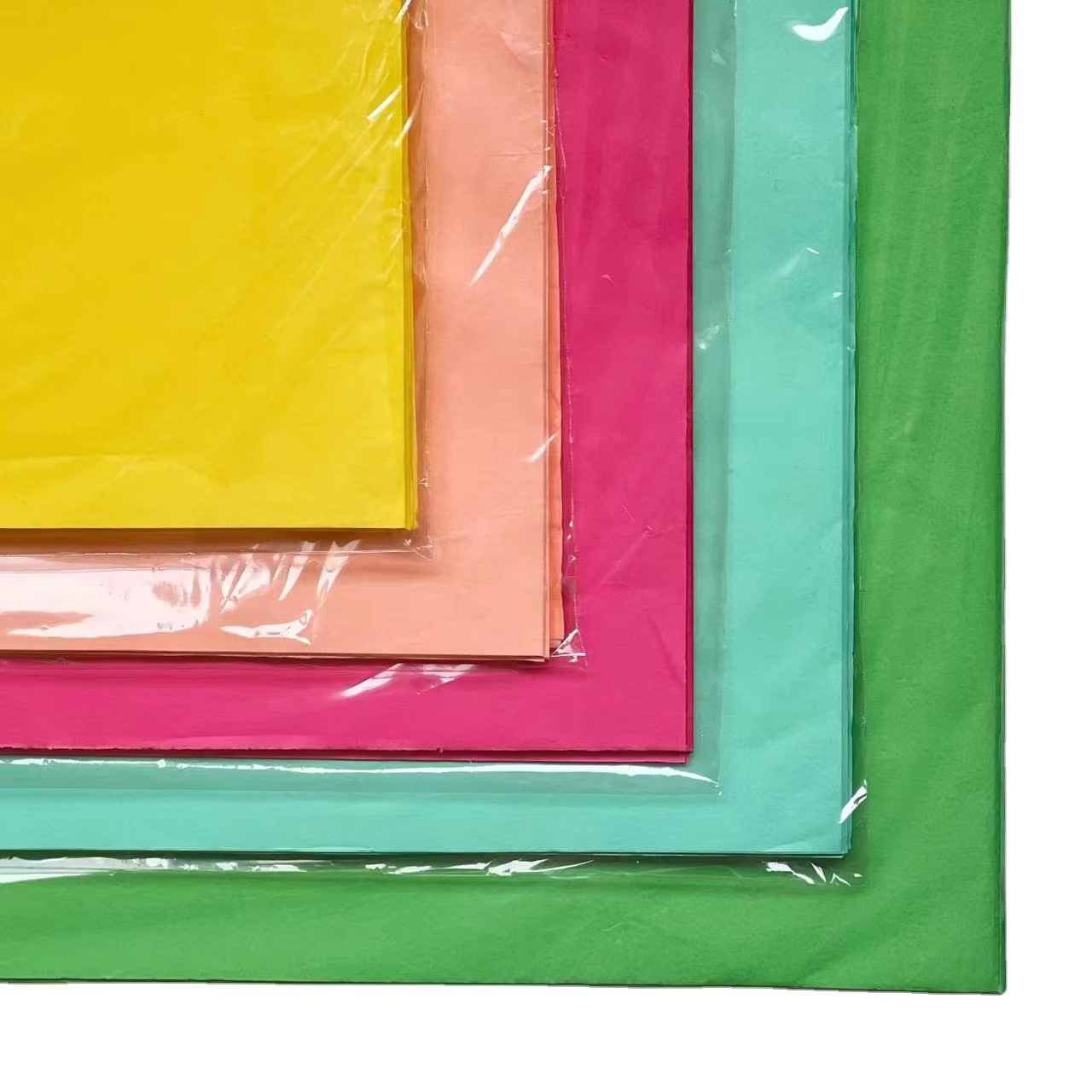How to Verify Quality from a Colored Tissue Paper Manufacturer
Understanding GSM and Material Composition for Quality Assessment

What Is GSM and Why It Matters in Colored Tissue Paper Quality
The GSM measurement tells us about how dense tissue paper actually is, which affects how long it lasts and what it can do. When we look at higher GSM numbers around 40 to 60, these papers tend to be thicker and stronger, making them great choices for fancy gift wrapping or premium packaging needs. On the flip side, those lighter weight options with GSM between 15 and 25 work well for things like napkins or facial tissues where softness matters more than strength. Getting consistent GSM across production runs really matters too. If there's more than a 5% difference from one batch to another, printers start having problems during their commercial jobs. The Tissue Industry Report showed this inconsistency led to roughly 12% of all bulk orders being rejected last year, so maintaining quality control remains essential for manufacturers who want to avoid costly mistakes down the line.
Measuring GSM Accurately Using a GSM Scale
Getting accurate GSM measurements means having the right tools and sticking to standard procedures. Most manufacturers rely on a GSM cutter along with an electronic scale, all according to those ASTM D3776 guidelines they follow. Take this example: when someone cuts out a 10 square centimeter piece that weighs about 0.18 grams, that translates to 18 GSM material. Thickness matters too. The gauges usually read somewhere between 0.08 and 0.15 millimeters thick. And here's why precision counts so much: studies indicate even a tiny 0.03 mm difference in thickness can knock down folding endurance by as much as 30 percent. That's a big deal for anyone working with materials where durability is important.
Virgin Pulp vs. Recycled Materials: Impact on Strength and Safety
Virgin pulp fibers actually have about two to three times better tear resistance compared to what we get from recycled materials, so they tend to be the go to choice when strength matters most, think gift wrapping applications for instance. On the flip side though, adding some recycled content cuts down on environmental footprint significantly, around sixty percent according to the Environmental Protection Agency report from last year. Most leading paper producers strike a balance between these competing needs by mixing roughly seventy percent virgin fibers with thirty percent recycled material. This combination gives products around 28 Newtons of tensile strength while still passing all necessary environmental regulations. When shopping around, it's wise to steer clear of companies that use raw recycled pulp without proper processing since there can be tiny traces of stuff left behind like old ink residues or sticky substances that might actually present health concerns over time.
How Dyes and Fragrances Affect Tissue Integrity and Consumer Health
Bright colors definitely make things look better, but when too much dye is added (more than 8% of the material weight), it actually weakens the fibers and makes them prone to tearing, with tests showing around a 40% increase in breakage risks. Fragrance additives aren't great either. They tend to cut down on how well the fabric holds together when wet and also slow down how fast it absorbs liquids, roughly 15% worse performance overall. When making products for kids especially, it's worth going the extra mile for safety. Look for fabrics dyed with OEKO-TEX certified materials and scents labeled as hypoallergenic. These options have consistently proven to be much gentler on skin, with studies finding they cause about 92% fewer cases of rashes and irritation compared to regular non-certified stuff out there.
Evaluating Physical Performance: Thickness, Softness, and Durability
Assessing Thickness and Softness for End-Use Suitability
Manufacturers should look for those that measure paper thickness in microns (µ) and assess softness using established tactile rating systems. For luxury packaging applications, most experts recommend around 30 to 35 microns to ensure the structure holds up properly. Personal care products like facial tissues generally work best somewhere between 22 and 26 microns, finding that sweet spot where the material feels comfortable yet still maintains necessary strength. A recent industry report from 2023 showed something interesting too: nearly 8 out of 10 customers will walk away from gift wrapping they find too rough or scratchy. This highlights just how critical it is to match the actual feel of materials with what people actually want when they buy products wrapped in paper.
Using a Thickness Gauge and Burn Test to Verify Physical Properties
Thickness gauges that measure down to about 1.5 microns plus controlled burn testing form the backbone of material quality checks. When we look at virgin pulp, it tends to burn away completely leaving nothing but clean white ash behind. Recycled materials tell a different story though they usually leave some sort of gritty residue after burning which tells us quite a bit about what actually makes up the product. Products that fall outside the acceptable thickness range by over 8% don't last nearly as long during those standard aging tests according to industry standards like ISO 12625-3. These two methods together give manufacturers real confidence about their products' performance over time.
Durability Requirements Across Packaging, Gift Wrap, and Personal Care Uses
Durability standards vary significantly by application:
- Packaging: Requires tear resistance ≥280 mN (measured via Elmendorf tester) to protect fragile contents
- Gift wrap: Needs ≥40 Sheffield units of smoothness to prevent cracking during folds
- Personal care: Must retain 85% wet strength after saturation for reliable use
Industry benchmarks require tensile strength of at least 15 kN/m² for commercial packaging tissues, verified through longitudinal stress testing. Leading producers now apply textile-derived abrasion tests to simulate over 500 handling cycles without surface degradation.
Ensuring Color and Print Consistency in Production
Verifying Uniform Dye Application Across Batches
Keeping dye application consistent is crucial for maintaining brand standards and building consumer confidence. According to recent industry data from the 2024 Material Quality Report, inconsistent dye dilution actually causes around one third of all color problems in tissue manufacturing. Smart companies have started using these fancy spectrophotometer devices that can spot even tiny color differences down to Delta E values below 0.8, which helps keep every production run looking exactly the same. When it comes to those intricate patterned designs, many factories are switching from old school hand spraying techniques to automated systems now. These new setups reduce mistakes made by workers by roughly two thirds and create much more even coverage across products. Especially important in sectors like premium paper goods where appearance really matters to customers.
Checking Print Accuracy for Patterns and Branding Elements
Misaligned prints or blurred logos diminish professional presentation. High-quality manufacturers implement a three-stage verification process:
- Digital pre-press proofs cross-referenced with brand style guides
- On-press registration checks using microscopic alignment markers
- Post-production inspections with 5x magnifiers for fine detail review
This layered approach reduces print errors by 92% compared to single-point checks.
Meeting Commercial Color Standards (e.g., Pantone) in Manufacturing
Sticking to international color standards such as Pantone's Matte Surface Collection helps keep colors looking the same on everything from product boxes to store shelves. According to some industry reports from last year, around three out of four companies working with tissues insist their suppliers have official Pantone certification. Top manufacturers often mix traditional ISO 2846-5 ink guidelines with special drying rooms that maintain constant temperatures, which makes sure colors stay true even after printing. For those worried about sustainability, there are now natural dye alternatives that hit about 95% of Pantone's target colors, though they still need to pass strict REACH regulations regarding safety when touching human skin. While these green options work well enough for most applications, some designers do notice slight differences compared to conventional methods.
Implementing In-Process and Final Quality Testing Protocols
Key Stages of Quality Control in a Colored Tissue Paper Manufacturer’s Workflow
Quality control starts at the beginning with checking raw materials. We use GSM scales to make sure the pulp density is right according to what we need. While things are being made, there's constant monitoring going on too. Every so often, about every fifteen or twenty minutes really, they check how well the dye spreads through the material and measure the tensile strength with properly calibrated equipment. At the end of the line comes final testing which involves rubbing tests for colorfastness and putting samples through various environmental conditions like high humidity levels to see if they hold up in actual usage scenarios. Plants that have these comprehensive testing procedures running throughout their operations tend to find around 40 something percent fewer defects compared to facilities that only do spot checks here and there when time permits.
Combining Instrumental Testing with Visual Inspection to Reduce Defects
When checking for problems on product surfaces, visual inspections catch things like streaks or uneven coloring. But there's also instrument based testing that gives hard numbers. Thickness gauges keep measurements within about 0.05mm range, and those fancy spectrophotometers make sure colors match Pantone standards with deviations under 2.0 Delta E units. Top manufacturing plants actually spend time teaching their workers how to connect what they feel (like how soft something feels to the touch) with actual measurements such as GSM values between 22 and 30 grams per square meter for high quality products. They also check burn tests results carefully fine ash indicates pure pulp content whereas granular remains point to recycled materials. Combining these approaches catches around 9 out of 10 potential issues both functionally and aesthetically before anything leaves the factory floor, research into packaging quality suggests.
Common Pitfalls: Overreliance on Visual Checks Alone
When companies depend just on what their eyes can see, they're actually missing out on about two thirds of all hidden problems related to how thick the material is and how strong it holds together, according to recent checks across the tissue manufacturing sector. Factories that stick with manual checks alone tend to deal with three times as many returns from customers who get products that tear too easily or have colors running where they shouldn't. For anyone serious about maintaining good quality throughout production, there's really no alternative but to bring in proper testing equipment at key points along the way. Most experienced producers will tell you these tests need to happen when materials first come into the facility, after the dyeing process completes, and right before anything gets packed for shipping to stores.
Verifying Certifications, Compliance, and Supplier Reliability
Essential Certifications: FSC, ISO, and REACH Compliance for Safe Production
When choosing suppliers, look for those with FSC, ISO 9001/14001, and REACH certifications first. The FSC label means they're following sustainable forest practices. ISO standards show they've got systems in place for both quality control and environmental responsibility. And REACH certification is important because it confirms that the dyes and other additives used in products pass strict EU tests for harmful substances like heavy metals and potential allergens. Products meeting REACH requirements actually cut down on dangerous chemical transfer by around 78% when compared to stuff without proper certification according to data from the EU Chemicals Agency back in 2023. That kind of reduction makes a real difference in product safety over time.
Meeting International Health and Environmental Standards
For manufacturers operating across different regions, there's no getting around local regulations when it comes to food contact materials. In the United States, they need to follow FDA 21 CFR guidelines, while European producers have to meet those tricky EU Ecolabel standards for sustainable products. When making tissues that touch sensitive skin, companies go for coatings that are not only non-toxic but also pH balanced so customers don't end up with redness or discomfort after use. Many eco-conscious paper mills have adopted closed loop water systems these days. Some report cutting their water usage down somewhere around 40%, which helps them hit those ISO 14064 carbon accounting goals too. The actual implementation can be challenging though, balancing environmental benefits against operational costs remains a constant concern for plant managers everywhere.
Conducting Factory Audits and Supplier Verification for Long-Term Trust
Third-party audits should assess:
- Calibration records for GSM and thickness measurement equipment
- Segregated storage for food-grade versus industrial dyes
- Wastewater treatment systems aligned with local discharge limits
A 2023 supplier reliability study revealed that manufacturers with documented audit trails experience 92% fewer defect-related recalls. For high-volume buyers, quarterly onsite audits are recommended to review batch testing logs and raw material certificates of analysis, ensuring sustained compliance and performance.










